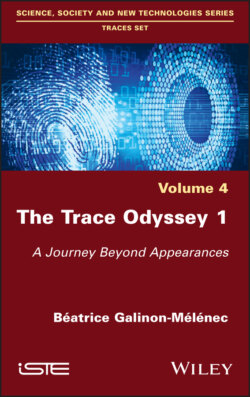The Trace Odyssey 1

Реклама. ООО «ЛитРес», ИНН: 7719571260.
Оглавление
Beatrice Galinon-Melenec. The Trace Odyssey 1
Table of Contents
List of Illustrations
List of Tables
Guide
Pages
The Trace Odyssey 1. A Journey Beyond Appearances
Acknowledgements
Introduction. Establishment of the Roadmap. I.1. Preamble
I.2. The call of digital society for new forms of traceability
I.3. Enthusiasm for the place of the trace in crime series
I.4. The investigation, an approach also used in the social sciences
I.5. Investigations and indices, two related concepts
I.6. Distinguishing between “trace anthropocentrée” and “trace ontologique”
I.7. From “trace anthropocentrée” to the signe-trace
I.8. Need for agreement on terminology
I.9. Objective of The Trace Odyssey: following the trace interpreted as a consequence
I.10. Confronting points of view
I.11. Social construction in the face of confronting points of view
I.12. Axioms underpinning The Trace Odyssey project
Box I.1.Ten axioms as a basis for The Trace Odyssey
I.13. The corps-trace at the heart of the relationship between the individual and the “milieu”
I.14. Permanent evolution of the corps-trace
I.15. Homme-trace, a universal anthropological paradigm
I.16. Towards a progressive figuration of the “ecosystem-trace” apparatus
I.17. Conclusion: The Trace Odyssey 1, roadmap
I.18. Bibliography
1. Beyond the Triviality of the Trace. 1.1. Preamble
1.2. Contact traces
1.2.1. “Corps-trace” and Locard’s principle
1.2.2. Technology-assisted papillary trace reading
1.2.3. Animals, readers of the primary traces of humans
1.3. Humans, readers of traces bearing witness to the passage of animals
1.4. Technology at the service of deferred interpretation
1.4.1. Conséquences-traces of the action by the “operator” and the “spectator”
1.4.2. Punctum
1.4.3. Emotional interference in interpretation
1.4.4. Part of the invisible
1.4.5. Authentication of photographic representation
1.4.6. Automatic recording and its evidentiary value
1.5. Techne as a trace of the evolution of “Homme-Trace”
1.6. Trace visibility and invisibility. 1.6.1. Questioning our current perception of reality
1.6.2. Example in the criminal domain
1.7. Digital application
1.8. Interaction between milieu37, traces from the body and “corps-trace”38
1.8.1. Conséquences-traces without an apparent physicality
1.8.2. Uncontrollable emersive signes-traces
1.8.3. Return of the repressed
1.8.4. Trauma traces
1.9. Conclusion: beyond the natural character of the trace
1.10. Bibliography
2. Gateway to the Digital World. 2.1. Preamble
2.2. Role of attention
2.3. Identifying the trace
2.4. Specificity of the digital trace
2.5. Digital universe, a space designed by humans
2.6. Rules of a digital society
2.7. Capta before data
2.8. Transforming capta into data
2.9. Reading data
2.10. Risks associated with uncoupling and interpretation
2.11. Conclusion: mute data and interpretative risks
2.12. Bibliography
3. The Lettrure from Yesterday to Today. 3.1. Preamble
3.2. From reading the heavens to the power of the cartographer
3.2.1. Ancestral rock writing
3.2.2. Power of the cartographer
3.3. Key role of the dominants interprétatifs
3.4. Algorithms behind the screen6
3.5. Humans behind the algorithm
3.6. Individuation of meaning
3.7. Considering writing as a trace of an absence
3.8. Writing at the expense of the lettrure
3.9. Traduttore, traditore16
3.10. Example of a chaining of conséquences-traces
3.11. Mechanisms of the ecosystem of electronic traces and digital humanities
3.12. Conclusion: role of humans in the cogs of the digital21 ecosystem
3.13. Bibliography
4. Understanding Traces with Forensic Science. 4.1. Preamble
4.2. Self-learning machines and open-source software
4.2.1. Performance of self-learning machines
4.2.2. Double face of techne
4.3. Trace and forensic science
4.4. Role of circumstances in the indexing of meaning
4.5. Trace collection and indexing of meaning
4.6. Collected traces and classification inventory
4.6.1. Cases of DNA transfer
4.6.2. Technical progress to identify traces in the bodies of criminals
4.6.3. Being accountable to interpretations
4.7. Discretization and bias
4.8. Conséquences-traces of the choice of indices
4.9. Embodied semiotics of the investigator
4.10. Intrinsic embodied semiotics of each investigator
4.11. Conclusion: of human beings, technology, and interpretation
4.12. Bibliography
5. A Complex Dynamic Process. 5.1. Preamble1
5.2. New milestone
5.3. Veiled Real
5.4. Consequences of semiotic choices
5.5. Assumptions related to the term signe-trace
5.5.1. Muteness of the trace
5.5.2. Discretization of the Real by humans
5.5.3. A human being considered as a Homme-trace
5.6. Difference between each homme-trace
5.7. Relationship with digital space
5.8. Interactions and relationships at the heart of processes
5.9. Conclusion: signes-traces and abductive reasoning
5.10. Bibliography
Conclusion. The Ichnos-Anthropos. C.1. Preamble. C.1.1. Initial project
C.1.2. Reference to Homer’s Odyssey
C.1.3. Embarking on the adventure of the Homme-trace program
C.2. Homme-trace as an anthropological paradigm transversal to the history of hominids
C.2.1. Reflection on some figures and graphs representing the points of synthesis
C.2.2. Limits of this first Odyssey
C.3. Ichnos-Anthropos on the shoulders of anthropology
C.3.1. Inseparability of anthropogenesis and technogenesis
C.3.2. Evolution of the corps-trace through the human/milieu evolution
C.3.3. Spotlighting the plasticity of the brain
C.3.4. Role of emotion
C.3.5. Identity over the course of life: between ipse and idem
C.4. Evolution of ecosystems
C.4.1. Digital filter bubbles
C.4.2. The question of judgment
C.5. Contribution of the paradigm to certain artificial intelligence models. C.5.1. Robots, companions of the Homme-trace of tomorrow
C.5.2. Robots designed based on the Homme-trace paradigm
C.6. Integration of robots into the human living environment
C.7. Conclusion: integrating the ethical dimension in choices
C.8. Bibliography
Glossary
References
Index. A, B, C
D, E, F
G, H, I
J, L, M
N, O, P
R, S, T
U, V, W
WILEY END USER LICENSE AGREEMENT
Отрывок из книги
Traces Set
.....
A.9. the perception of each individual results from an “activation-interaction” between nodes of conséquences-traces;
A.10. the rational deconstruction of the history of the traces constituting the reality perceived by humans is so complex that they cannot hope to achieve it. At most, they can claim to provide a simplified representation of reality, known as “simplexity43”.
.....